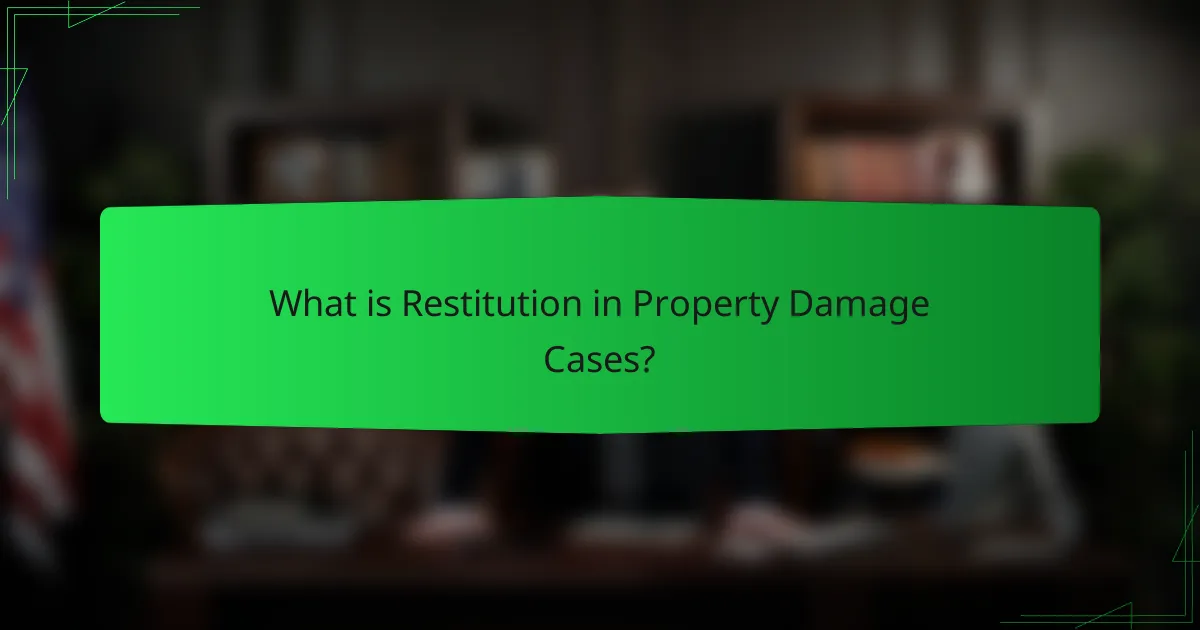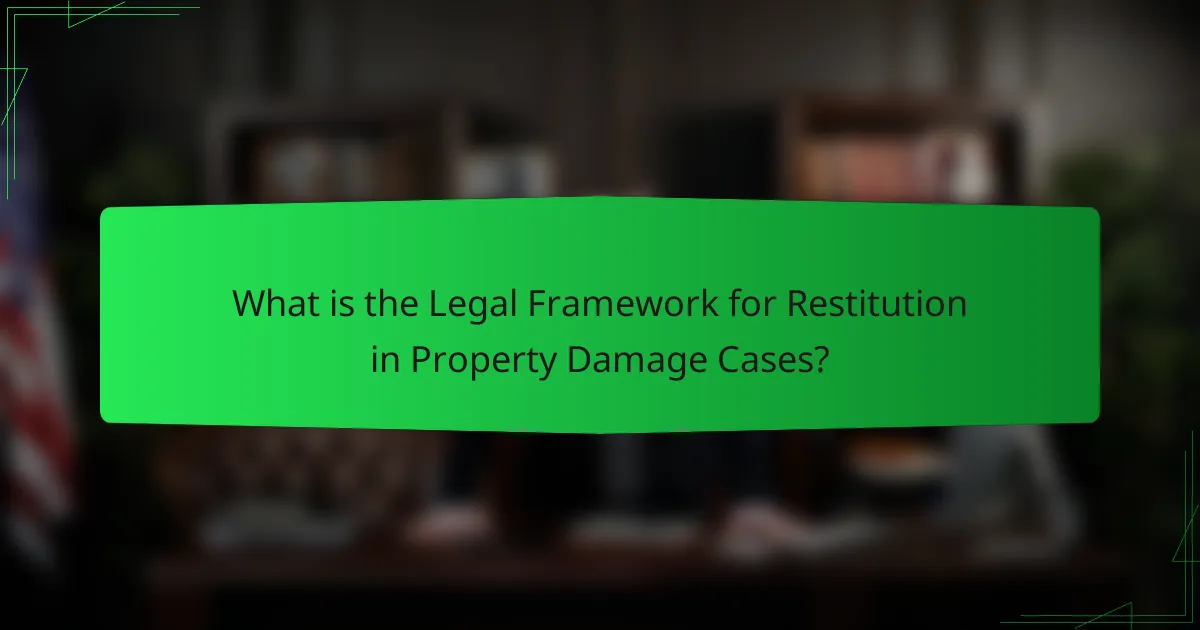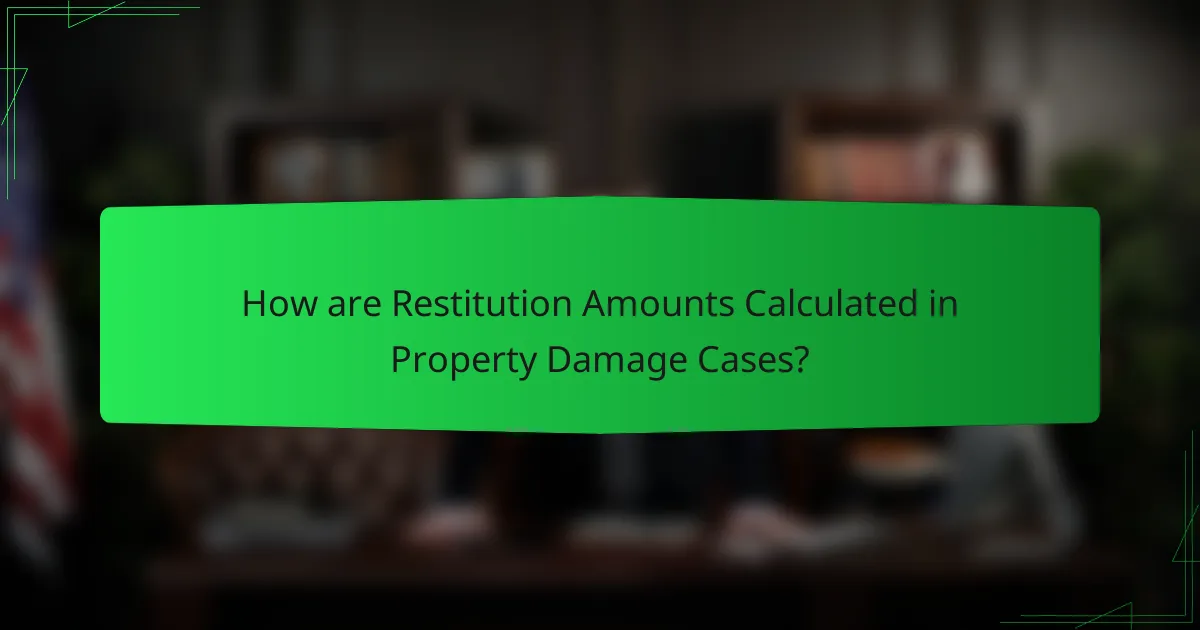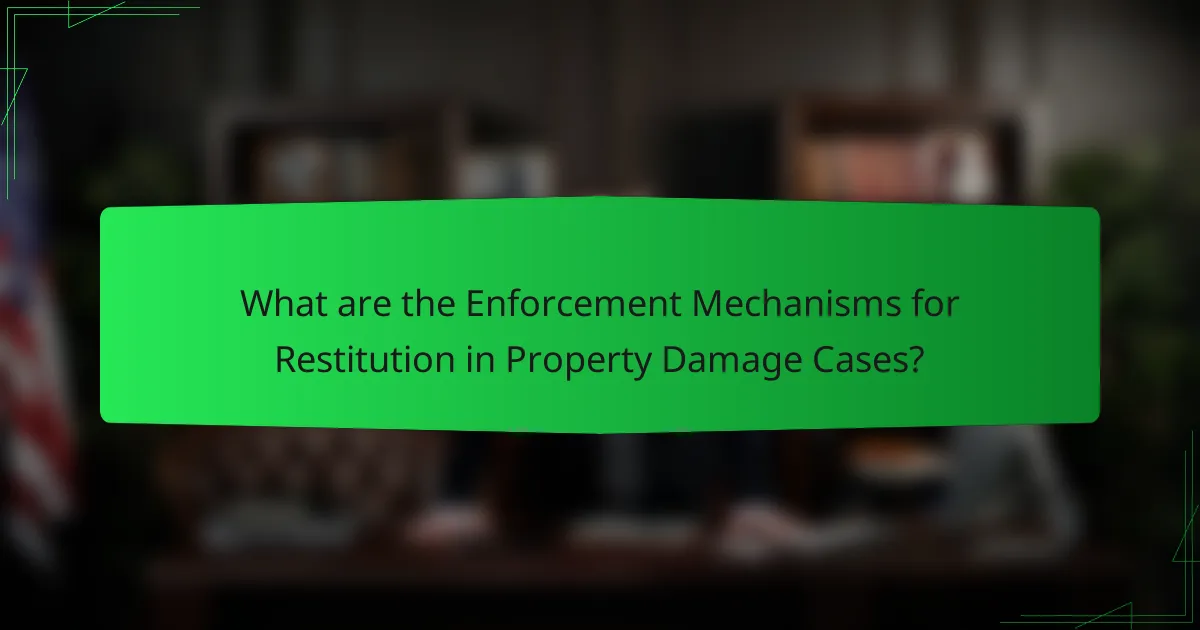Restitution in property damage cases refers to the legal obligation to compensate victims for losses incurred due to damage to their property. This article outlines the legal framework governing restitution, including relevant statutes and case law, as well as the principles of tort and contract law that establish liability and damages. It details the methods used to calculate restitution amounts, focusing on actual losses, repair costs, and depreciation. Additionally, the article examines enforcement mechanisms such as court orders, liens, and garnishments, which ensure that victims receive appropriate compensation for their losses. Understanding these key elements is essential for navigating restitution claims in property damage scenarios.

What is Restitution in Property Damage Cases?
Restitution in property damage cases refers to the legal obligation to compensate a victim for losses incurred due to damage to their property. This compensation aims to restore the victim to their original financial position before the damage occurred. Courts typically determine restitution based on the cost of repairs or the fair market value of the property at the time of the damage. In many jurisdictions, restitution is mandated by law in civil cases involving property damage. The principle of restitution seeks to prevent unjust enrichment of the party responsible for the damage. For example, if a person damages a neighbor’s fence, they may be required to pay for the repairs. This ensures that the victim is not left bearing the financial burden of the damage caused by another party.
How is restitution defined in legal terms?
Restitution in legal terms refers to the compensation awarded to restore a party to their original position after a loss. It aims to prevent unjust enrichment by requiring the wrongdoer to return or compensate for the value of the benefit received. This concept is often applied in cases of property damage, contractual breaches, and torts. Legal precedents establish that restitution can involve monetary payments or the return of specific property. Courts evaluate the extent of loss and the benefit gained to determine the appropriate restitution amount. The principle is rooted in common law and is supported by statutes in various jurisdictions.
What are the key legal principles underlying restitution?
The key legal principles underlying restitution include unjust enrichment, the principle of restoring the status quo, and the requirement of a benefit conferred. Unjust enrichment occurs when one party benefits at the expense of another without a legal justification. Restoring the status quo aims to return parties to their original positions prior to the unjust enrichment. The requirement of a benefit conferred means that restitution is only available when one party has received a benefit that would be unjust to retain. Courts often apply these principles to ensure fairness and prevent unjust outcomes in property damage cases. These principles are foundational in various legal systems and are supported by numerous case law precedents that illustrate their application in practice.
How does restitution differ from other forms of compensation?
Restitution differs from other forms of compensation in that it specifically aims to restore the victim to their original position before harm occurred. Unlike damages awarded for pain and suffering, which are subjective, restitution focuses on quantifiable losses. It requires the wrongdoer to return specific benefits gained from the wrongful act. For example, in property damage cases, restitution involves compensating for the actual loss of property value. This contrasts with punitive damages, which are intended to punish the offender rather than restore the victim. Courts often determine restitution based on the fair market value of the lost property. Thus, restitution is primarily about reparation, while other compensatory forms may address broader impacts.
Why is restitution important in property damage cases?
Restitution is important in property damage cases because it compensates victims for their losses. This financial remedy helps restore the victim to their original position before the damage occurred. It ensures accountability by holding the responsible party liable for their actions. In many jurisdictions, restitution is mandated by law, reinforcing the principle of justice. Studies indicate that victims who receive restitution experience higher satisfaction with the legal process. Moreover, restitution can deter future misconduct by demonstrating the financial consequences of property damage. Overall, restitution plays a crucial role in upholding legal and moral standards within property damage cases.
What role does restitution play in restoring property rights?
Restitution plays a crucial role in restoring property rights by compensating victims for losses incurred. It aims to return the injured party to their original position before the wrongdoing occurred. This legal remedy ensures that the offender is held accountable for their actions. In cases of property damage, restitution may involve monetary compensation or the return of specific property. Courts often determine the amount based on the fair market value of the lost or damaged property. This process reinforces the principle of justice by addressing the imbalance caused by the offense. Moreover, restitution can deter future violations by signaling the consequences of harming others’ property rights. Therefore, restitution is essential for both reparation and deterrence in property rights restoration.
How does restitution impact the relationship between parties involved?
Restitution can significantly impact the relationship between parties involved. It serves as a means to restore balance after harm has occurred. When one party compensates another, it acknowledges wrongdoing. This acknowledgment can foster trust and accountability. Conversely, failure to provide restitution may lead to resentment and ongoing conflict. Studies show that effective restitution can enhance communication between parties. It can also facilitate reconciliation and future cooperation. Therefore, the manner in which restitution is handled directly influences the dynamics of the relationship.

What is the Legal Framework for Restitution in Property Damage Cases?
The legal framework for restitution in property damage cases encompasses statutes and case law that govern recovery. This framework aims to restore the injured party to their pre-damage condition. Key legal principles include tort law and contract law, which establish liability and damages. Statutory provisions may vary by jurisdiction, affecting claims and recovery processes. Courts often apply the principle of “make whole,” ensuring victims receive compensation for losses. Specific laws may address particular types of property damage, such as environmental harm or personal injury. Judicial precedents shape interpretations of restitution claims. These elements collectively form the legal basis for seeking restitution in property damage scenarios.
What laws govern restitution in property damage cases?
Restitution in property damage cases is primarily governed by tort law. Tort law allows victims to seek compensation for losses due to another party’s wrongful actions. Each state has its own statutes and case law that outline the principles of restitution. Common legal frameworks include the Uniform Commercial Code and various state-specific laws. These laws determine how damages are calculated and enforced. Courts often rely on precedents set in previous cases to guide restitution decisions. Proof of damages is typically required to establish entitlement to restitution. This legal foundation ensures that victims can recover losses incurred from property damage incidents.
Which jurisdictions have specific restitution laws?
Restitution laws exist in various jurisdictions across the United States. States such as California, New York, and Texas have specific restitution statutes. These laws provide guidelines for compensating victims of property damage. In California, for instance, the Penal Code specifies restitution for victims in criminal cases. New York’s Criminal Procedure Law also mandates restitution as part of sentencing. Texas law allows for restitution in both civil and criminal contexts. Each state has its own procedures and requirements for restitution claims.
How do federal and state laws differ regarding restitution?
Federal and state laws differ regarding restitution primarily in their scope and application. Federal laws, such as the Mandatory Victims Restitution Act, require restitution for certain federal offenses, focusing on compensating victims for specific losses. State laws vary widely in how they define restitution, the types of offenses covered, and the calculation methods used. For instance, some states may include restitution for emotional distress, while federal laws typically do not. Additionally, the enforcement mechanisms for restitution can differ, with some states offering more robust processes for collecting payments from offenders. This variance reflects the broader legal framework within which restitution is applied across different jurisdictions.
What are the key elements required to establish a claim for restitution?
The key elements required to establish a claim for restitution are the enrichment of one party, the impoverishment of another, and the absence of a legal justification for the enrichment. Enrichment refers to the benefit received by one party, often in the form of property or money. Impoverishment indicates a loss or detriment suffered by the other party. Legal justification can include consent or contractual agreement. Each element must be proven for a successful claim. Courts assess these factors based on evidence presented in the case.
What evidence is necessary to support a restitution claim?
To support a restitution claim, evidence must demonstrate the loss incurred. This includes documentation of property damage, such as photographs and repair estimates. Witness statements can also corroborate the extent of the damage. Receipts for expenses related to the damage strengthen the claim. Additionally, police reports or insurance claims provide official records of the incident. The burden of proof lies with the claimant to establish the value of the loss. Clear and organized evidence improves the likelihood of a successful restitution claim.
How does the burden of proof affect restitution claims?
The burden of proof significantly impacts restitution claims by determining which party must provide evidence to support their case. In restitution claims, the claimant typically carries the burden of proof. This means they must demonstrate the validity of their claims through sufficient evidence. If the claimant fails to meet this burden, their claim may be dismissed. The standard of proof in civil cases, including restitution, is usually “preponderance of the evidence.” This standard requires that the evidence presented by the claimant is more convincing than the evidence presented by the opposing party. Therefore, a strong presentation of evidence is crucial for the success of restitution claims.

How are Restitution Amounts Calculated in Property Damage Cases?
Restitution amounts in property damage cases are calculated based on the actual loss suffered by the victim. This includes the cost of repairs or replacement of damaged property. Courts may also consider depreciation of the property. Additionally, they may factor in any loss of use during the repair period. Evidence such as repair estimates, invoices, and appraisals is often required to support the claim. The goal is to restore the victim to their pre-damage condition financially. Legal standards may vary by jurisdiction, influencing how restitution is determined. Accurate documentation is crucial for a successful restitution claim.
What methods are used to calculate restitution amounts?
Restitution amounts are calculated using various methods, primarily including replacement cost, fair market value, and actual cash value. Replacement cost determines the expense required to replace damaged property with a new equivalent. Fair market value assesses the price at which the property would sell in an open market. Actual cash value considers the replacement cost minus depreciation. Courts may also factor in additional damages, such as loss of use or emotional distress. These methods ensure restitution reflects the true loss experienced by the victim.
How do economic damages influence restitution calculations?
Economic damages directly affect restitution calculations by quantifying the financial losses incurred by a victim. These damages typically include medical expenses, lost wages, and property repair costs. The calculation of restitution aims to restore the victim to their pre-damage financial state. Courts assess the total economic damages to determine the appropriate restitution amount. Accurate documentation of economic losses is essential for a fair calculation. Studies indicate that precise economic assessments lead to more equitable restitution outcomes. For instance, a report by the National Center for State Courts highlights the importance of detailed economic damage evaluations in restitution cases.
What factors are considered when determining non-economic damages?
Factors considered when determining non-economic damages include the severity of the injury, the impact on quality of life, and emotional distress. Courts evaluate pain and suffering, loss of companionship, and mental anguish. Additionally, the duration of the impact and the plaintiff’s age may influence the assessment. Jurisdictions may vary in how they calculate these damages based on local laws. Evidence from medical records and expert testimony often supports claims for non-economic damages. These factors collectively help establish the extent of harm beyond economic losses.
How do courts assess the value of property damage?
Courts assess the value of property damage by determining the cost to repair or replace the damaged property. This assessment often involves expert testimony and appraisals. Courts may consider the fair market value of the property before the damage occurred. They also account for depreciation and any prior damage. The replacement cost is typically used when repair is not feasible. Courts may look at invoices, estimates, and photographs to substantiate claims. Additionally, local market conditions can influence property value assessments. These methods ensure a fair compensation for the affected party.
What role do appraisals play in the restitution process?
Appraisals play a crucial role in the restitution process by determining the fair market value of damaged property. Accurate appraisals provide a basis for calculating compensation owed to victims. They assess the extent of damage and the cost of repairs or replacement. This information is essential for legal proceedings and negotiations. Appraisers utilize industry standards and methodologies to ensure objectivity. Their evaluations are often used in court to support claims. Proper appraisals can expedite the restitution process by providing clear financial data. Ultimately, they help ensure that victims receive appropriate compensation for their losses.
How can depreciation affect restitution amounts?
Depreciation can significantly reduce restitution amounts in property damage cases. When calculating restitution, the value of the damaged property is assessed. Depreciation accounts for the decrease in value over time due to wear and tear or obsolescence. This means that the restitution amount reflects the current market value, not the original purchase price. For example, if a vehicle originally valued at $20,000 depreciates to $12,000, the restitution owed would be based on the $12,000 figure. Courts often use depreciation schedules to determine these values. Therefore, the effect of depreciation directly impacts the financial compensation awarded to the victim.

What are the Enforcement Mechanisms for Restitution in Property Damage Cases?
Enforcement mechanisms for restitution in property damage cases include court orders, liens, and garnishments. Court orders compel the responsible party to pay restitution as determined by a judge. Liens allow the injured party to claim a legal right over the property of the responsible party until the restitution is paid. Garnishments enable direct deductions from the responsible party’s wages or bank accounts to satisfy the restitution amount. These mechanisms ensure that victims receive compensation for their losses. Legal frameworks often dictate the specific processes and requirements for each mechanism. For example, a court order must be filed and enforced through the judicial system. Each mechanism serves to uphold the principle of accountability in property damage cases.
How is restitution enforced once a judgment is made?
Restitution is enforced through various legal mechanisms once a judgment is made. The court may issue an order requiring the debtor to pay the specified amount. If the debtor fails to comply, the creditor can pursue collection actions. These actions may include wage garnishment, bank levies, or property liens. The creditor must file the necessary documents with the court to initiate these processes. Additionally, the court can hold the debtor in contempt for non-compliance. This can lead to further legal consequences, including fines or imprisonment in some cases. Enforcement methods vary by jurisdiction but generally follow established legal protocols.
What legal actions can be taken to enforce restitution orders?
Legal actions to enforce restitution orders include wage garnishment, bank account levies, and property liens. Wage garnishment allows creditors to collect a portion of the debtor’s earnings directly from their employer. Bank account levies enable the seizure of funds from the debtor’s financial accounts. Property liens secure the creditor’s interest in the debtor’s property until the restitution is paid. Courts may also issue contempt orders against debtors who fail to comply. These actions ensure that restitution is collected effectively. Each method follows specific legal procedures to uphold the rights of the creditor.
How do garnishments and liens work in restitution enforcement?
Garnishments and liens are legal tools used in restitution enforcement. Garnishments allow creditors to collect debts directly from a debtor’s wages or bank accounts. A court order is required to initiate a garnishment. This order mandates the employer or bank to withhold a portion of the debtor’s income or funds.
Liens, on the other hand, are claims placed on a debtor’s property. They secure the debt by ensuring that the creditor can collect if the property is sold. A lien can be placed on real estate or personal property. This process often requires a court judgment confirming the debt.
Both garnishments and liens help ensure that victims receive restitution. They provide mechanisms for enforcing payment when a debtor fails to comply voluntarily. Legal statutes govern the processes for both garnishments and liens, ensuring they are executed properly.
What challenges can arise in the enforcement of restitution?
Challenges in the enforcement of restitution include difficulty in locating assets and debtors. Many individuals may hide or dispose of assets to evade payment. Legal complexities can arise from varying state laws regarding restitution. Enforcement mechanisms may be limited, making it hard to collect owed amounts. Additionally, debtors may declare bankruptcy, which can discharge restitution obligations. Courts may face challenges in prioritizing restitution claims among other debts. Victims often experience delays in receiving restitution payments. These factors collectively hinder the efficient enforcement of restitution orders.
How can debtors evade restitution payments?
Debtors can evade restitution payments through various methods. They may hide assets to make them unavailable for seizure. Debtors can also underreport income to lower their payment obligations. Some may file for bankruptcy, which can temporarily halt restitution payments. Others may relocate to avoid enforcement actions. Additionally, debtors might use fraudulent tactics, such as creating fake debts. These actions complicate the enforcement of restitution orders. Legal systems often struggle to track and recover funds in such cases.
What remedies are available for creditors facing enforcement issues?
Creditors facing enforcement issues have several remedies available to them. These include obtaining a court judgment to enforce payment. A court judgment can authorize wage garnishment or bank account levies. Creditors may also seek liens on the debtor’s property. This allows creditors to claim the property if debts remain unpaid. Additionally, creditors can initiate bankruptcy proceedings against the debtor. This process may lead to asset liquidation to satisfy debts. Each of these remedies is supported by legal frameworks that govern creditor rights and debtor obligations.
What best practices should parties follow in restitution cases?
Parties in restitution cases should follow several best practices. First, they must gather comprehensive evidence of the property damage. This includes photographs, receipts, and expert testimonies. Second, parties should document all communications related to the restitution claim. Keeping a clear record helps establish a timeline and accountability. Third, they should seek legal advice early in the process. Experienced attorneys can provide guidance on legal rights and obligations.
Additionally, parties should engage in open negotiations. Effective communication can lead to amicable settlements. They should also be prepared to present their case clearly in court if necessary. This involves organizing evidence and practicing key arguments. Finally, parties should understand the applicable laws and precedents in their jurisdiction. Familiarity with legal standards can strengthen their position in the case.
Restitution in property damage cases is a legal obligation requiring compensation to victims for losses incurred due to property damage, aiming to restore their original financial position. The article outlines the legal framework governing restitution, including key principles such as unjust enrichment and the requirement of a benefit conferred. It details the calculation methods for restitution amounts, factors influencing these calculations, and the enforcement mechanisms available to ensure compliance with restitution orders. Additionally, it addresses challenges in enforcement and best practices for parties involved in restitution claims.